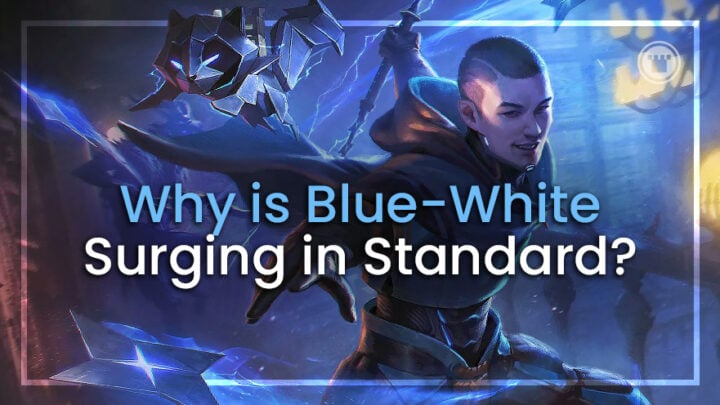If now seems like an odd time to be talking about new breakout Standard decks, don’t worry – I’m just as surprised to be here writing about them! It’s been two full months since new cards were last added to the format, and thanks to Innistrad Remastered taking first spot on the 2025 release schedule it’s going to be another full month from now before that changes.
I’m not complaining about what is nowadays a rare chance to stop and really dig into what should be a more solved, stable metagame. It’s just worth pointing out that, for some reason, that’s really not what we see happening at all. Even without actual changes to the card pool, there are multiple fresh archetypes – many of them UW – suddenly surging to prominence.
FAE BLADE BOUNCES BACK
You could argue that this first deck isn’t entirely a novel idea, so much as a horrifying chimaera stitched together from two or three extant Standard lists. But the combination of effects here seems to be proving greater than the sum of those parts, and there are also enough (extremely spicy) new notes in the brew that it deserves to be recognized as its own thing.
I actually wrote about the “Fae Blade” deck, a.k.a. WB Sacrifice, back when it hit the scene post-Bloomburrow. The deck broke from more traditional WB midrange builds to play more of a Stax/Pox type attrition game, with Nurturing Pixie the unlikely star player holding that plan together.
The one-drop faerie proved perfect fit for that weird aggro-value playstyle, resetting ETBs on Hopeless Nightmare and the signature Tithing Blade. The latter removal spell made Fae Blade a meta-beater at a time when Snakeskin Veil was running rampant, but it never quite graduated beyond that moment.
Then ten days ago at SCG CON Atlanta, a Nurturing Pixie archetype unexpectedly re-entered the battlefield!
This esper list, piloted to an eye-catching 12-3 finish by Nicole Tipple, welds the aggressive curve of Fae Blade together with ideas from UB Curiosity and the Temur Otters combo deck. The mad genius of this build is that it somehow ends up having tighter synergy than any of the decks it’s drawing from!
We knew Nurturing Pixie was the most effective card in Fae Blade, with its hyper-efficient combination of utility and beatdown. But without any comparable cards to back it up, the WB builds were forced to lean more into the grindy sacrifice playstyle.
Committing to blue, however, suddenly unlocks Fear of Isolation and This Town Ain’t Big Enough – eight more spells that can simultaneously improve our boardstate and reset key ETB effects. We also get Kaito, Bane of Nightmares, who in addition to being straight-up better than our previous value engines can also add another “reset” by bouncing Pixie with Ninjutsu.
Stormchaser’s Talent is light-years better than Novice Inspector even before you consider its now-famous synergy with This Town Ain’t Big Enough. Throw in Optimistic Scavenger and we’re now up to a whopping 18 one-mana spells, 14 of which become creatures and all of which deal damage!
This extremely low curve helps mitigate the inherent clunkiness of self-bounce gameplay. Meanwhile every maindeck spell except Tithing Blade and Go for the Throat either triggers Eerie directly or bounces another card that can, setting the ceiling for those Scavengers surprisingly high. MTGO player MicroPago has even tried adding 2-3 copies of Entity Tracker to further capitalize on this aspect of the list, earning Top 8 and Top 32 records in Standard Challenges with it.
Higher card quality, instant-speed interaction and a faster clock combine to make this the most compelling, successful and popular build of Fae Blade yet – not to mention a flexible starting point for the next wave of experimentation.
PLAIN(S) AND SIMPLE
That new take on Fae Blade wasn’t even the sole UW aggro deck to hit the spotlight at that SCG CON weekend.
The color combination is coming into its own in current Standard, with a lot of compelling and overlapping synergy packages available – convoke, artifacts, enchantments, tokens. But you can also say no to all of these in favor of “playing the good cards” – a plain-jane style of aggro which carried Zhao Li to 6th place in Atlanta, and has since been further optimized by Argentinian pro Matias “Levunga” Leveratto.
Once again we can look at this deck as a tantalizing blend of proven ideas: the curve and gameplan are imitating the dominance of UB Curiosity lists, while a lot of the pieces are familiar from Jeskai Convoke. This has led to Zhao and Levunga’s results being lumped in with “Azorius Convoke” on various metagame data sources – but with no convoke spells in the 75 and no explosive token generation or team-pump effects, that label feels misplaced.
If you ask me, the current build feels more akin to the Leyline Axe-centric list popularized by MTGO’s D00mwake in the first week of Foundations Standard. But that deck was also more all-in aggressive, investing a ton of slots on cards like Zoetic Glyph to try and maximize the value of a turn-0 equipment. Levunga’s build has the confidence in its spells to ease off the gas just a little; inviting longer games with the value of Enduring Curiosity and the interaction of Sheltered by Ghosts and Floodpits Drowner.
The preponderance of flyers alone is enough to give you a respectable clock, particularly if you can use Steel Seraph or Mockingbird to make some flying Bunnicorns. You can also still play the Axe/Zoetic Glyph combo in this version by replacing the vehicles and three-drops, as MTGO user DoctorIdiot did to top 8 most recent Standard Challenge.
The straightforward, generic premise of this deck leaves me without a lot to really analyse here, but the results posted both by its creators and innovators demanded I give it full attention. My favorite development has been certain players bringing more Split Up into the 75, in some cases even the maindeck: the various crewable vehicles and Warden of the Inner Sky mean your team should be able to consistently dodge the “destroy all untapped creatures” side of the effect.
Despite Levunga himself flagging that the archetype fares poorly against Esper Self-Bounce, he seems committed to honing it further so long as the current status quo of Standard holds. But at the same time on the far opposite end of the UW deck spectrum, we can find a group of hungry young players trying their best to shatter it.
BREAKTHROUGHS IN OMNI-SCIENCE
One assumes that Wizards R&D would not have allowed the reprinting of Omniscience in Foundations unless they had already explored its potential for combos in current Standard. The card’s limitless potential on the tabletop inevitably turns it into a deckbuilding puzzle. Specifically, how can you get it into play ASAP and how do you incorporate a reliable way to end the game post-Omniscience with minimal impact on your pre-omniscience performance?
That last part might throw a few people off, but it’s a crucial part of optimizing decks that reach the point of infinite turns or mana: every deck slot you don’t waste on traditional win conditions is one which can better help you stay alive and get your Omniscience online. Besides, it’s not like you really need dedicated finisher cards if you can cast your whole deck in one turn!
Regardless of whether Wizards planned on it happening or not, we have now been shown the answers to this Omniscience puzzle, courtesy of the deckbuilders at Team Trecani.
You can get it into play early and reliably with the use of Abuelo’s Awakening, which reanimates a discarded or milled copy of the enchantment as a 1/1 (or larger) creature token. Being a creature might seem like a downside, opening up your key combo piece to more removal. But you’ve got a wealth of (now zero mana) counterspells and other interaction to navigate such situations.
More importantly, the upside of being a creature token is that Omniscience will no longer be bounced by Season of Weaving… meaning you can then continue using your unlimited mana to rebuild the rest of your boardstate instantly. If that’s not game-ending enough for you, having a Wish effect on the ETB of Invasion of Arcavios allows you to loop it and Season of Weaving indefinitely to (with a modicum of luck) draw and cast your deck.
What Team Trecani specifically do with the Invasion is draw a chunk of their sideboard instead: not only the Season of Weaving itself or combo protection like Get Lost, but their actual “win condition” spell – Unnerving Grasp. Like Callous Dismissal in the old Nexus of Fate turns decks, the combination of universal bounce spell and token generation is enough to win from almost any position given enough casts, so there’s no need for any more slots to be put towards those winners.
The rest of Team Trecani’s decklist is laser-focused and simple: entirely cantrips and draw spells to help you dig for combo pieces when you’re setting up, or dig for a second Invasion once you have the key enchantment in play. Grand Abolisher out of the board does obnoxiously good work shutting down almost any countermeasures your opponent might have prepared. Once they exhaust themselves fighting over that spell instead, they should be easy to roll over in spite of their efforts.
If there’s still some concern around opposing interaction in (what should be) the short window between “going for Omniscience” and the handshake, you can usually slow roll the combo for a few extra turns, waiting to sculpt a perfect hand and build up the mana to guarantee you land that killshot. Just make sure you practice your combo turns if you’re going to play the deck online – it is both click- and clock-intensive without the luxury of verbal shortcutting!
DEEP BLUE WATERS
Having looked into these emerging decklists and their origins more closely, I do feel like we can have a go at answering my questions from the top of this article. The sudden upsurge of UW is simply the latest example of new powerful cards giving top deckbuilders the impetus to revisit powerful cards which had previously been written off.
Prior to the format rotating with Bloomburrow, the UW color combination was very nearly invisible. Other than UW Soldiers, none of its set themes had really amounted to Standard-playable decks.
But with the power level of the format reset by rotation, UW cards old and new have had a chance to see daylight and benefit from re-evaluation. The fact that many of these decks have taken months to appear just feels like a natural consequence of how many new cards are being added!
We can see by the kaleidoscope of possible builds around each of these deck concepts how large the back-catalogue of spells to revisit was – significantly larger than it ever was before the switch to three-year rotations. On top of that, we have to remember how unprecedentedly huge a set Foundations was (and is) for players to try and evaluate. With all that in mind, I wouldn’t be surprised if we continue to see these off-schedule metagame shifts for at least a few more months – assuming that Aetherdrift and subsequent sets each bring brewers’ attention back to another group of previously-overlooked gems.

Tom’s fate was sealed in 7th grade when his friend lent him a pile of commons to play Magic. He quickly picked up Boros and Orzhov decks in Ravnica block and has remained a staunch white magician ever since. A fan of all Constructed formats, he enjoys studying the history of the tournament meta. He specializes in midrange decks, especially Death & Taxes and Martyr Proc. One day, he swears he will win an MCQ with Evershrike. Ask him how at @AWanderingBard, or watch him stream Magic at twitch.tv/TheWanderingBard.

